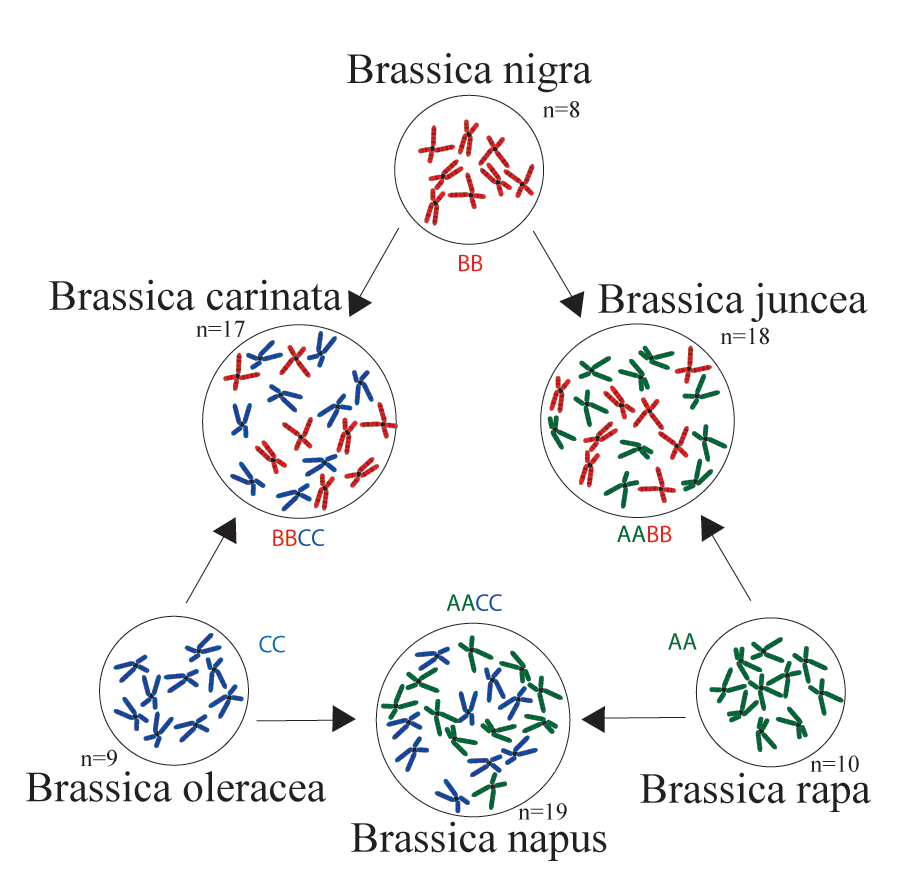Triangle of U on:
[Wikipedia]
[Google]
[Amazon]
 The triangle of U ( ) is a theory about the evolution and relationships among the six most commonly known members of the plant genus '' Brassica''. The theory states that the genomes of three ancestral
The triangle of U ( ) is a theory about the evolution and relationships among the six most commonly known members of the plant genus '' Brassica''. The theory states that the genomes of three ancestral
diploid
Ploidy () is the number of complete sets of chromosomes in a cell, and hence the number of possible alleles for autosomal and pseudoautosomal genes. Here ''sets of chromosomes'' refers to the number of maternal and paternal chromosome copies, ...
species of ''Brassica'' combined to create three common tetraploid vegetable
Vegetables are edible parts of plants that are consumed by humans or other animals as food. This original meaning is still commonly used, and is applied to plants collectively to refer to all edible plant matter, including edible flower, flo ...
s and oilseed crop species. It has since been confirmed by studies of DNA and proteins.
The theory is summarized by a triangular diagram that shows the three ancestral genomes, denoted by AA, BB, and CC, at the corners of the triangle, and the three derived ones, denoted by AABB, AACC, and BBCC, along its sides.
The theory was first published in 1935 by Woo Jang-choon, a Korean- Japanese botanist
Botany, also called plant science, is the branch of natural science and biology studying plants, especially Plant anatomy, their anatomy, Plant taxonomy, taxonomy, and Plant ecology, ecology. A botanist or plant scientist is a scientist who s ...
(writing under the Japanized name "U Nagaharu"). Woo made synthetic hybrids between the diploid
Ploidy () is the number of complete sets of chromosomes in a cell, and hence the number of possible alleles for autosomal and pseudoautosomal genes. Here ''sets of chromosomes'' refers to the number of maternal and paternal chromosome copies, ...
and tetraploid species and examined how the chromosomes paired in the resulting triploids.
Woo's theory
The six species are The code in the "Chr.count" column specifies the total number of chromosomes in each somatic cell, and how it relates to the number ofchromosome
A chromosome is a package of DNA containing part or all of the genetic material of an organism. In most chromosomes, the very long thin DNA fibers are coated with nucleosome-forming packaging proteins; in eukaryotic cells, the most import ...
s in each full genome set (which is also the number found in the pollen or ovule
In seed plants, the ovule is the structure that gives rise to and contains the female reproductive cells. It consists of three parts: the ''integument'', forming its outer layer, the ''nucellus'' (or remnant of the sporangium, megasporangium), ...
), and the number of chromosomes in each component genome. For example, each somatic cell of the tetraploid species ''Brassica napus'', with letter tags AACC and count "2=4=38", contains two copies of the A genome, each with 10 chromosomes, and two copies of the C genome, each with 9 chromosomes, which is 38 chromosomes in total. That is two full genome sets (one A and one C), hence "2=38" which means "=19" (the number of chromosomes in each gamete
A gamete ( ) is a Ploidy#Haploid and monoploid, haploid cell that fuses with another haploid cell during fertilization in organisms that Sexual reproduction, reproduce sexually. Gametes are an organism's reproductive cells, also referred to as s ...
). It is also four component genomes (two A and two C), hence "4=38".
The three diploid species exist in nature, but can easily interbreed because they are closely related. This interspecific breeding allowed for the creation of three new species of tetraploid ''Brassica''. (Critics, however, consider the geological separation too large.) These are said to be allotetraploid (containing four genomes from two or more different species); more specifically, amphidiploid (with two genomes each from two diploid species).
Further relationships
The framework proposed by Woo, although backed by modern studies, leaves open questions about the time and place of hybridization and which species is the maternal or paternal parent. ''B. napus'' (AACC) is dated to have originated about 8,000 or 38,000–51,000 years ago. The homologous part of its constituent chromosomes has crossed over in many cultivars. ''B. juncea'' (AABB) is estimated to have originated 39,000–55,000 years ago. As of 2020, research on organellar genomes shows that ''B. nigra'' (BB) is likely the "mother" of ''B. carinata'' (BBCC) and that ''B. rapa'' (AA) likely mothered ''B. juncea''. The situation with ''B. napus'' (AACC) is more complex: some specimens have a ''rapa''-like organellar genome, while the rest indicate an ancient, unidentified maternal plant. Data from molecular studies indicate the three diploid species are themselves paleohexaploids.Allohexaploid species
In 2011 and 2018, novel allohexaploids (AABBCC) located at the "center" of the triangle of U were created by different means, for example by crossing ''B. rapa'' (AA) with ''B. carinata'' (BBCC), or ''B. nigra'' (BB) with ''B. napus'' (AACC), or ''B. oleracea'' (CC) with ''B. juncea'' (AABB), followed by chromosome duplication of the triploid (ABC) offspring to generate doubled haploid (AABBCC) offspring. In addition, two stable allohexaploid (AABBSS) intergeneric hybrids between Indian mustard (''B. juncea'', AABB) and white mustard (''Sinapis alba'', SS) were created in 2020 by protoplast fusion.See also
*Cultivar
A cultivar is a kind of Horticulture, cultivated plant that people have selected for desired phenotypic trait, traits and which retains those traits when Plant propagation, propagated. Methods used to propagate cultivars include division, root a ...
* Hybridisation
References